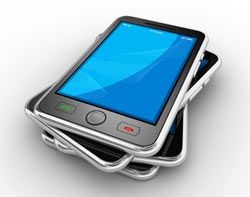Back when desktops ruled the roost, many ran with an agent that acted as a conduit to the IT department's policy engine and ensured that certain functions were carried out properly.
These included software updates, overnight shutdown or sleep, and monitoring user activity, as well as enforcement of security policies. It removed as much control from the user as was compatible with their function and role.
One of the agent's key roles was to ensure data on that device was protected by the company’s backup software.
In many ways, the current proliferation of mobile devices echoes that of the desktop in previous years, and many of the issues are similar.

Mobile device management (MDM) has risen to meet those challenges and was cited as the key mobility project by 73% of respondents in ComputerWeekly.com’s recent UK IT spending priorities survey.
But backup as a key priority was nowhere to be seen. Most organisations don’t back up mobile devices and backup products for mobile hardware are scarce. So could it be that mobile management plays a role in ensuring adequate data protection, or does MDM leave a backup gap for mobile devices that still needs to be filled?
MDM definitions
Mobile device management systems do much the same job as their desktop counterparts, but must deal with complexities created by the device’s mobile nature. For example, network connections can be irregular and occasional and when the employee owns the device, the company cannot always dictate what happens to it.
Gartner originally defined mobile device management as "a range of products and services that enable organisations to deploy and support corporate applications to mobile devices… enforcing policies and maintaining the desired level of IT control across multiple platforms".
Since then, Gartner has updated its definition, with MDM morphing into enterprise mobility management (EMM).
According to Gartner's Magic Quadrant for Enterprise Mobility Management Suites 2014, EMM differs from MDM because: "Enterprise mobility management suites consist of policy and configuration management tools and a management overlay for applications and content intended for mobile devices based on smartphone OSs. They are an evolution from previous-generation mobile device management products that lacked application and content management."
However, the aim of MDM (and EMM) is still to optimise the functionality and security of mobile devices within the enterprise, while simultaneously protecting the corporate network.
So, typically, the system will include a server component that issues commands to mobile devices, and a client or agent on the device to receive and implement commands.
Features include the management and support of mobile applications, mobile policy management, inventory management, security management and telecommunications service management.
It may also include the ability to distribute applications, data and configuration settings and patches – and, occasionally,file synchronisation and sharing, data security tools, and support for mobile devices, irrespective of their ownership.
Mobile backup alternatives
But nowhere in these definitions of MDM does the topic of data protection arise explicitly.
Gartner views mobile data protection as a separate market, citing different sets of features and benefits, and of suppliers.
The research firm defines mobile data protection as software security methods that enforce confidentiality policies by encrypting data and then defending access to it. In other words, in this category of products and services, front-line defence of company data is undertaken by encryption rather than duplication.
This is intended to protect against the additional risks that mobility attracts. These include the most common scenario in which a device is lost, stolen or shared, at which pointcompliance becomes an issue for any organisation that stores personally identifiable information.
Such devices may also contain corporate data. Gartner has predicted that, by 2017, 40% of enterprise contact information will have leaked into social networks such as Facebook and LinkedIn, and that twice as many employee-owned devices will be compromised by malware than those owned and managed by enterprises.
MDM versus mobile backup
As we have seen in TechTarget research, most mobile devices are not backed up. Even laptops, similar enough to desktops in terms of hardware and OS to run corporate backup applications and agents, are backed up only 47% of the time.
It is unclear why this is so, but products that back up mobile hardware are few and far between, with most traditional enterprise backup products making little or no provision for mobile devices.
CommVault Simpana's Edge Data Protection module is notable for its inclusion of support for mobile devices. It allows end-users to access their protected data using either a web portal or apps for smartphones and tablets.
Meanwhile, Druva's inSync product is designed for endpoint data protection of laptops, desktops, smartphones and tablets.
Perhaps mobile backup is not considered all that important?Tony Lock, distinguished analyst at Freeform Dynamics, says most smartphones create very little content and are used mainly for email and web access, and so have minimal backup requirements.
But tablet usage is changing, says Lock. "People using tablets and convertibles are doing genuine production of content, in which case there is a need for data protection," he points out.
Despite this, few enterprises have prioritised mobile backup, so end-users resort to halfway-house backup solutions, such as emailing important documents to themselves.
Also, many cloud-connected mobile devices connect to services such as Dropbox, which is part of the mobile-related shadow IT operation that has emerged in many organisations.
A disincentive to mobile backup is that it is difficult. Not only are connections likely to be occasional and low bandwidth in nature, but when a device is employee-owned, it will also contain personal data and enterprises only want to expend effort and consume storage for their own data.
Will MDM replace backup?
So the key question remains: will the growing adoption of MDM result in improved mobile device backup?
Judging by the product features highlighted in Gartner's Magic Quadrant, MDM is no substitute for dedicated backup software.
But there may be a role for MDM in future, says Lock
“As MDM solutions evolve – and they are trying to do everything to see what works – they will eventually include data protection,” he says. “Right now, they might cover a particular hardware platform but rarely do everything, while every enterprise has every device known to man.
“So MDM will eventually include backups and then IT will need to develop backup policies. But for the moment, MDM products and services are still immature.”
Source : http://www.computerweekly.com



